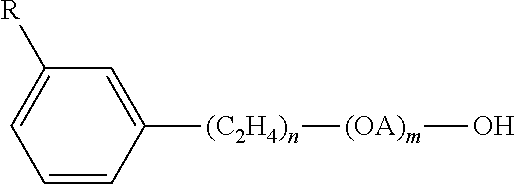Adhesive remover compositions and methods of use
a technology of adhesive remover and composition, applied in the field of cleaning compositions, can solve the problems of high cost of healthcare textiles, inability to remove many types of medical adhesive from healthcare textiles, and inability to remove many types of medical adhesive from textiles, etc., and achieve the effects of effectively removing adhesive soil, effective removal of adhesives, and effective removal of medical adhesives
- Summary
- Abstract
- Description
- Claims
- Application Information
AI Technical Summary
Benefits of technology
Problems solved by technology
Method used
Image
Examples
example 1
[0165]Three colors of napkins were selected, black, red, and white. Each napkin was cut into four equal size pieces and soiled with three drops of corn oil, vegetable oil, and canola oil. The soiled napkins were cleaned in a regular wash at temperatures between about 100° F. and about 200° F., with the exemplary adhesive remover composition of Table 2, a traditional limonene-based detergent, and a traditional petroleum distillate-based detergent. The wash cycle information is provided in Tables 3-5. Upon completion of the wash cycles, the napkins were visually inspected to determine if oil residue was still visible. The results of the visual inspection are provided in Table 6 below. From reviewing Table 6 below it is apparent that the exemplary formula provided in Table 2 performed equally as well as traditional limonene-based and petroleum distillate-based detergents in removing common oil stains from fabric.
TABLE 3Wash Cycle with Exemplary Detergent of Table 2StepDoseNumberStep Ty...
example 2
[0166]Healthcare textiles were soiled with medical adhesives listed in Table 7. The soiled healthcare textiles were read on a HunterLab Colorquest XE Spectrophotometer. The soiled healthcare textiles were cleaned in a regular wash at temperatures between about 100° F. and about 200° F., with the exemplary adhesive remover composition of Table 2. The wash cycle information is provided in Table 3.
[0167]If soils were remaining after the regular wash, the textiles were put through a reclaim process, at temperatures between about 100° F. and about 210° F. During the reclaim process, the exemplary adhesive remover of Table 2 was used at 16 ounces per 100 pounds of laundry. Some of the medical adhesives were applied to two sets of healthcare textiles (as seen in Table 7) and the second set of soiled healthcare textiles was washed with a traditional limonene-based detergent as provided in Table 4.
[0168]These were intended for comparison with the medical adhesive composition of Table 2. The ...
PUM
 Login to View More
Login to View More Abstract
Description
Claims
Application Information
 Login to View More
Login to View More - R&D
- Intellectual Property
- Life Sciences
- Materials
- Tech Scout
- Unparalleled Data Quality
- Higher Quality Content
- 60% Fewer Hallucinations
Browse by: Latest US Patents, China's latest patents, Technical Efficacy Thesaurus, Application Domain, Technology Topic, Popular Technical Reports.
© 2025 PatSnap. All rights reserved.Legal|Privacy policy|Modern Slavery Act Transparency Statement|Sitemap|About US| Contact US: help@patsnap.com

